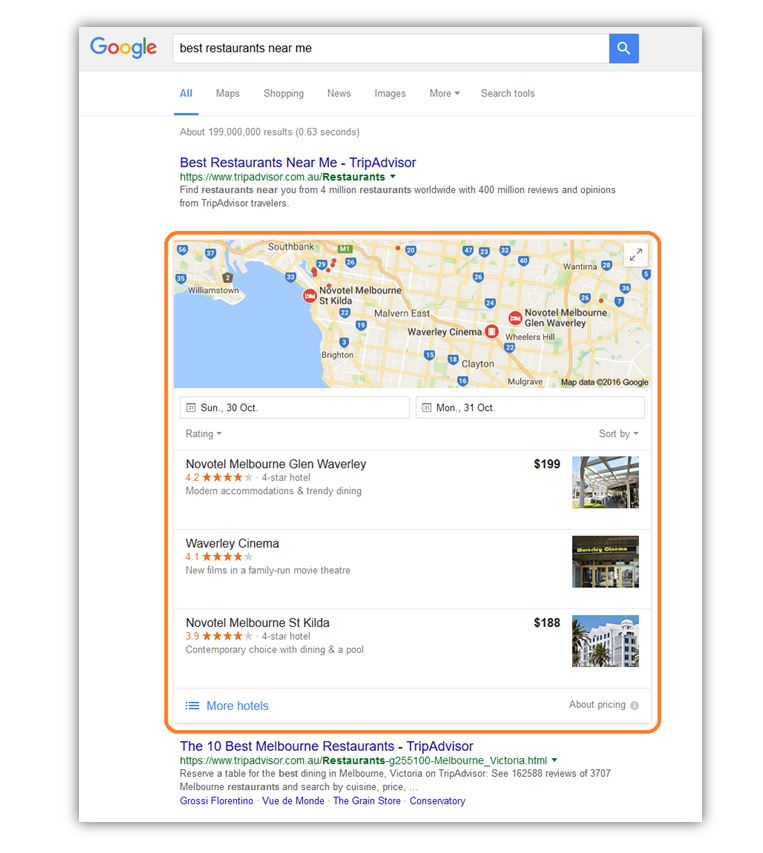
7 Local SEO Ranking Factors You Should Consider in 2016
As the majority of people reading this article would be aware, Search Engine Optimisation (SEO) is the strategic implementation of techniques used to rank a website higher than its competitors in search engines in an effort to attract more potential customers to the website.
The purpose of this article is to offer you some ideas on how to perform well in Local SEO, a subspecies of the larger animal that is SEO.
For a quick review, local SEO is focused on providing results that are relevant to a searcher based on their location.
So for example, if someone searches for ‘best restaurants’ on their desktop, tablet or smartphone, Google will return results that are suited to their physical location.

For the most part, Google updates generally act to level the playing field more than anything meaning that to be successful most business and SEO’s need to do what they are doing, but do it better! Unless of course, they are engaging in black hat SEO techniques…
A Foreword
Google usually changes its algorithm around 500-600 times every year. Although most of these are minor changes, we should still be aware of them.
Given that Google owns over 67% of the search engine market, it’s worth investing a little time to understand how it all works.
In 2014, among other minor updates, there were two big happenings that are worth mentioning; the launch of Google My Business and a major pigeon update.
Google My Business can now be used by small business owners to conveniently engage with their audience and respond to reviews quickly.
As for the resulting changes that came with the Pigeon update, this essentially required us to tighten up our SEO strategy and put even focus on what were already the main 4 considerations for local SEO – website, citations, reviews and backlinks.
Local SEO is a juggling act of several moving parts, each of which is important in its own right. Let’s have a look at them now and see what are the most important local SEO ranking factors.
1. On-Page Optimisation
The first thing consideration is elements of the website itself.
Do people see what they want when they come onto the website?
Is each page signalling the right things to Google?
Is the content unique and genuinely helpful to the visitor?
A number of onsite aspects need to be considered when you’re building and/or optimising the website. The title should have the right amount of keywords and each URL of the site needs to be SEO friendly.
Website content is what creates the spark, so making sure that there’s no duplicate content is a must. Also, logos and images should be optimised so that Alt tags are present, each image is surrounded by rich content and the file size is not too large or small.
In addition, the location of the business and telephone number needs to be made readily available and ideally should match the address shown on other offsite business pages including Google Plus and blogs.
Some people underestimate the significance of the navigation menu, leaving it poorly developed and non-indexable, which is a big mistake. When a visitor comes to the site, one of the first things that he/she looks at is the various tabs in the navigation menu.
Finally, Google Search Console needs to be set up correctly to ensure that your site can be crawled properly by bots.
2. Conversion rate optimisation
Having a website that converts visitors into customers is every business owner’s dream, but it isn’t necessarily all that easy to achieve.
People have different tastes in terms of the websites that appeal to them and often it’s best to try different approaches and track success. There are however a few elements that can are common among all good websites.
Is your phone number prominently displayed?
What about your call to action?
Is your site mobile-friendly?
Does your site have testimonials/reviews, readily available and easy-to-find for your visitors?
If you have answered these questions positively, it puts you in a good position.
Related article: The Essential Guide to Conversion Rate Optimisation
3. Google+ Profile
A separate Google+ profile for your business needs to be set up the right way. First of all, relevant information needs to be present and ideally the profile will be vibrant with links being shared, images posted and plenty of engagement with customers and other business.
Claiming the Google Local listing is also key to ensure that Google knows exactly where you are and knows that you are who you say you are.
4. Citation Building
The more places your business is listed in locally, the higher the chance that people will find you.
For this, you’ll need to submit your business in local directories and sites first, where your competitors have listed their businesses (this is generally a good rule to go by).
Don’t forget to create and claim your business listings on Bing, Yahoo, Yelp and other high traffic directories as this add a great deal of value.
Another most important consideration is to make sure your Business Name, Address and Phone number (NAP) is provided for each and every listing. You should fix some old listings which might have incorrect details – these need to be fixed to maintain consistency for structured citation signal.
5. Reviews
One of the best ways to get an idea of a business in this day and age is by looking at reviews online.
Your business should encourage customers to leave reviews and do your best to respond to the good reviews and bad reviews in a professional manner.
Many businesses hang their SEO hat on their review generation strategy and it’s only becoming more important as time goes on and social media becomes more relevant.
Related article: What is the Impact of Positive Online Reviews for Your Business?
6. Social
Social profiles are the key to keeping in touch with your target market.
If you want to build up along terms online marketing strategy, then you need to be all over social media including Twitter, Facebook, Foursquare, Instagram, Google+, depending on what’s relevant.
Make sure your social media profiles are linked from your website and keep active. Social media is, by definition, a place online where people gather.
And if you can spread the name of your business in that kind of environment, it’s only going to be a positive thing.
7. Backlinks
Conducting a link audit to reduce the number of unnatural links pointing to your website is a must, especially if you’re website has been around for a few years.
What was considered good practice 5 years ago might be considered spammy nowadays and often website owners find themselves listed in link farm sites and other directories that Google tries to avoid.
Use Google Search Console to find all your existing links and check out where your competitors are listed with Open Site Explorer, Majestic or other backlink analysis tools. Emulating their strategy is fair play.
Final Note
There are a few key things that we’re pretty confident will become even more important in 2016.
Responsive design is becoming the standard, so if you’re designing a new site certainly consider this. Google My Business is also going to take off, so keep it in check and update regularly. Overall, just stay alert and keep up to date on what’s happening in the industry and you’ll be fine!
Local SEO has changed over the years as Google’s algorithm forces business to come up with new strategies.
If you’re thinking that you can rest on your laurels, not touch your site and still continue to rank in the SERPS, then think again. With more competition than ever, there’s no room to slack off and ignore elements that everyone else is investing in. Juggling a few different things at once is what SEO is all about and highly necessary if you want your business to reach the top.
You read a lot. We like that
Want to take your online business to the next level? Get the tips and insights that matter.

